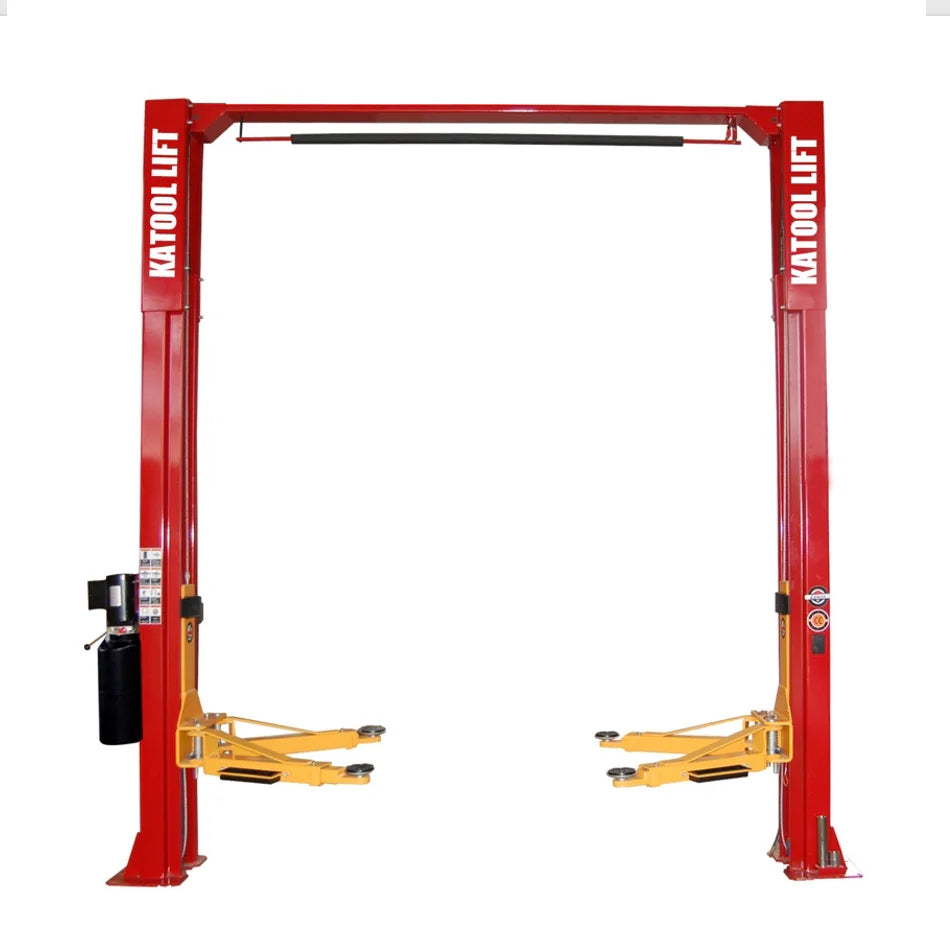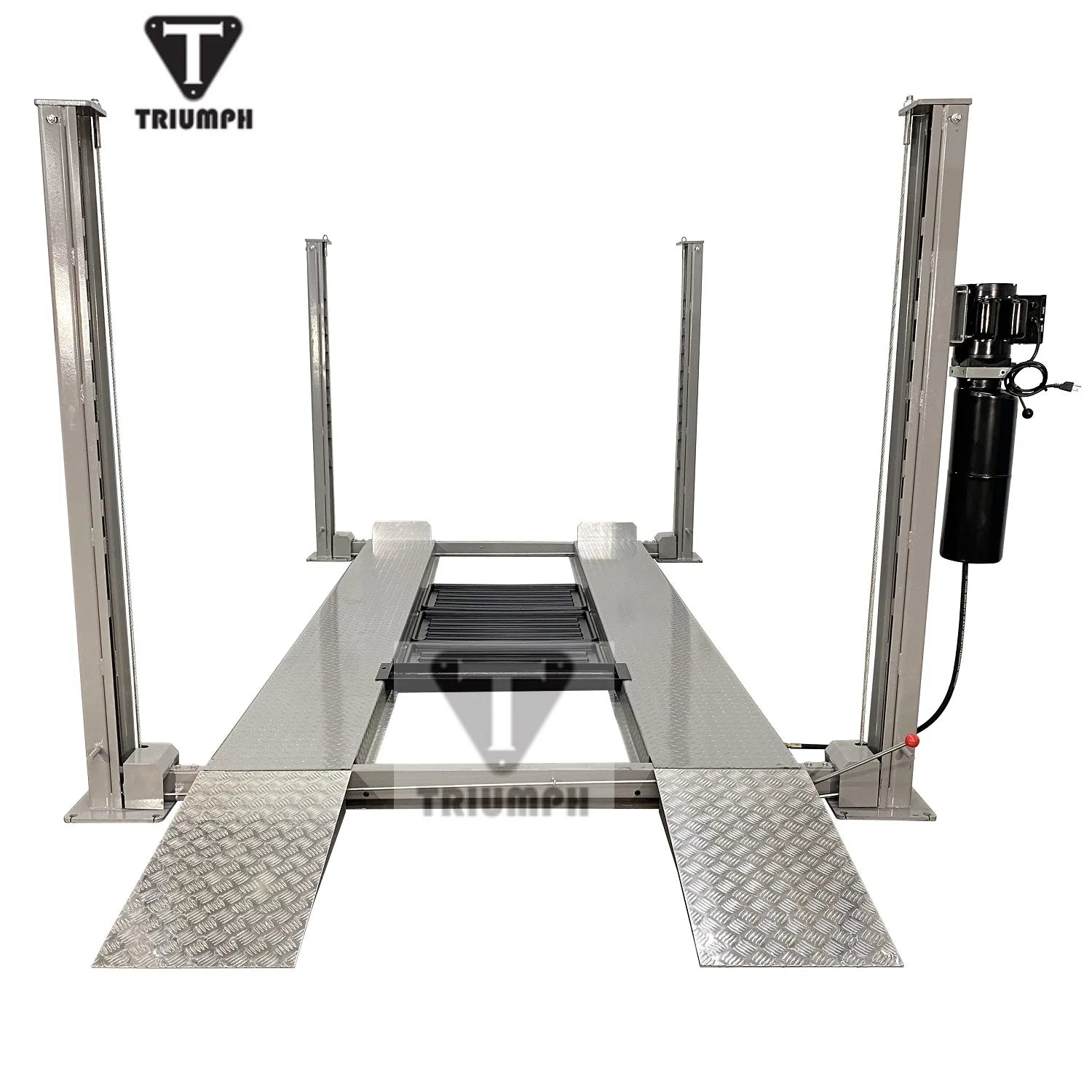
Bolting Down Your 4-Post Lift: When is it Necessary for Stability and Safety?
When it comes to lifting vehicles off the ground, whether it is to get them repaired, serviced, or stored, you do not want unstable or insecure equipment. One question that we get asked on a regular basis at Heavy Duty Garage is: “Should 4-post lifts be bolted down?”
Although the answer to this question depends on your particular needs, it is crucial to know what drives the necessity (or absence of the necessity) to bolt down your lift to the ground.
So, why does it matter? Do you need to bolt in some cases? And what can you do to optimize the installation of your 4-post lift?
Major Benefits of a 4-Post Lift
The 4-post lift has some advantages:
- Convenient Usage: Just drive on top of the runways, and the lift does it all. You will no longer be concerned with the need to make sure there are lift arms in-line with each other or even need to put the pads manually underneath the car.
- Safe and Secure: The weight of the vehicle is evenly distributed with 4-post lifts, and this is what makes them very stable, particularly when it comes to long-term vehicle storage.
- Adaptable to Service: 4-post lifts can be used to perform oil changes, brake inspections, or any other variety of maintenance. Other designs may be equipped with rolling jacks to lift all four wheels off the runways to access more.
With or without residential car stacking or commercial maintenance, a 4-post lift is a worthwhile investment to make in a garage.
At What Times Is It Necessary to Bolt Down a 4-Post Lift?
4-post lifts are flexible, which is their major characteristic. You can use them as freestanding or bolted down as required. Now, what about the times when it is a smart move to bolt your lift?
1. Commercial and Heavy-Traffic Use
In an auto garage or mechanic shop where a lot of heavy vehicles or repair work is being conducted, whereby the use of a jack lifting system is common, the necessary precautions would be to secure the lift on a good concrete foundation by screwing it down rather than risking its stability. A freestanding lift may become a burden under conditions of heavy traffic, unceasing loading/unloading, and the necessity for precision during repair work.
Bolting the lift so that it is stationary ensures that it does not move laterally, keeping it well aligned, stable, and preventing fixed parts such as cables, safety locks from overuse, which may cause them to wear out prematurely. Additionally, local codes or even insurance in business environments might even demand bolting the lift down in order to comply with regulations.
2. Heavy Duty Applications & Bigger Trucks
When you are loading heavier automobiles or exceeding the standard weight capacity of the lift, it is prudent to bolt the lift down to ensure extra safety. This happens more especially when you need to lift heavy-weight trucks or any other heavyweight vehicles. Bolting the lift will avoid over-straining the frame and will also facilitate the lift's optimal performance, even when used with heavier loads.
3. Unsmooth or Smooth Concrete Flooring
When your garage has non-flat or thinner concrete flooring, it is essential to bolt the lift. Any unevenness, however minor, will eventually result in the shifting or tilting of the lift, which might lead to incorrect use of the lift and eventually cause its collapse. These problems are addressed by bolting the lift to firmly secure it to the ground and make it stable at all times.
Situations Where a Freestanding 4-Post Lift is Safe to Use
Bolting the lift may not be needed in most residential garages. Here’s why:
1. The Home Use and Storage Ideal
The best type of lift to have in most home garages or spaces where you want to stack the cars is a freestanding 4-post lift. Such lifts are normally accompanied by large and solid baseplates, which evenly spread the weight of the vehicle. Provided that the floor is level, the lift is operated under its rated weight, and appropriately within its limitations, you could also operate it safely without any need to bolt it down.
2. Flexibility with Caster Kits
Most residential 4-post lifts include caster kits, thereby giving the equipment mobility. This feature can really save space or, alternatively, allow you to move the lift around. You can move it wherever you want in your garage or change the setting according to your requirements, and you can lock the casters so that it is secure when you are using it.
Nevertheless, you will still need level concrete in order to safely operate it, although you may be excused from bolting the lift to its base. The use of a flat surface ensures weight equilibrium on each of the four posts. Make sure that the lift has been installed on a floor that meets the manufacturer’s requirements (usually 4 inches thick concrete, 3,000 PSI concrete).
3. Periodic Light Maintenance
A freestanding 4-post lift will be more than enough if your lift is utilized mostly for light maintenance: oil changes, brake repair, tire rotations, etc. You just have to ensure that you use the lift according to the recommended weight of the manufacturer and perform upkeep according to the maintenance schedule. The other point is that you should place the lift in a location where it is not exposed to a lot of forces which may induce some shifting in the long term.
Dangers of Failing to Bolt Down Your Lift
Although freestanding 4-post lifts are considered stable by the majority of home users, risks will occur when bolting is omitted where necessary:
- Movement & Misalignment: Due to loading and unloading vehicles, and with time, there will be movement and even misalignment of the lift, which is more common in high-usage areas. This will result in imbalance during lifting or straining the safety devices, such as cables and locks.
- Overloading Problems: In a situation where you are using the lift with a vehicle that is close to the maximum weight, the lack of bolting may lead to an increase in the chances of the lift becoming unstable.
- Long-Term Wear: Freestanding lifts also tend to get worn out more quickly compared to bolted ones, especially in scenarios such as uneven floors or a lift that has to offer hard work.
Bolting Your Lift for Maximum Safety
In order to prevent all these possible problems, we suggest you bolt your lift in case you:
- Plan to use it in a busy/high-demand environment.
- Move heavier vehicles on a regular basis.
- Have an uneven garage floor or one that does not meet the manufacturer's requirements.
- Install the lift permanently in your garage.
With a secure lift, you guarantee safety, security, and compliance with local standards. It also safeguards your investment, as it will increase the life cycle of your lift and reduce the risks associated with its operation.
What 4-Post Lift Is Best for Your Garage?
When you are prepared to equip your garage with a high-quality 4-post lift, Heavy Duty Garage will take care of you. You can choose between freestanding or commercial-type lifts; we have a variety of trusted brands such as Triumph, Katool, and Weize.
The lift capacities range from 8,000 lbs to more than 14,000 lbs, so you can find the most fitting one according to your needs. Shop our 4-post lift collection now and find the perfect lift for your garage.
Final Reflections: Keep Your 4-Post Lift Safe
To sum it up, whether or not you bolt down a 4-post lift depends on its use. Light-duty freestanding lifts are a good choice for home garages. But in business installations, high use, or low floors, it is best to anchor your lift to provide extra safety and a longer service life.
Want to find the right lift that fits you? Our collection of 4-post lifts is available now; browse through today and contact our friendly team with any installation suggestions or inquiries. We are here to assist you in making your garage work harder, smarter and safer.

